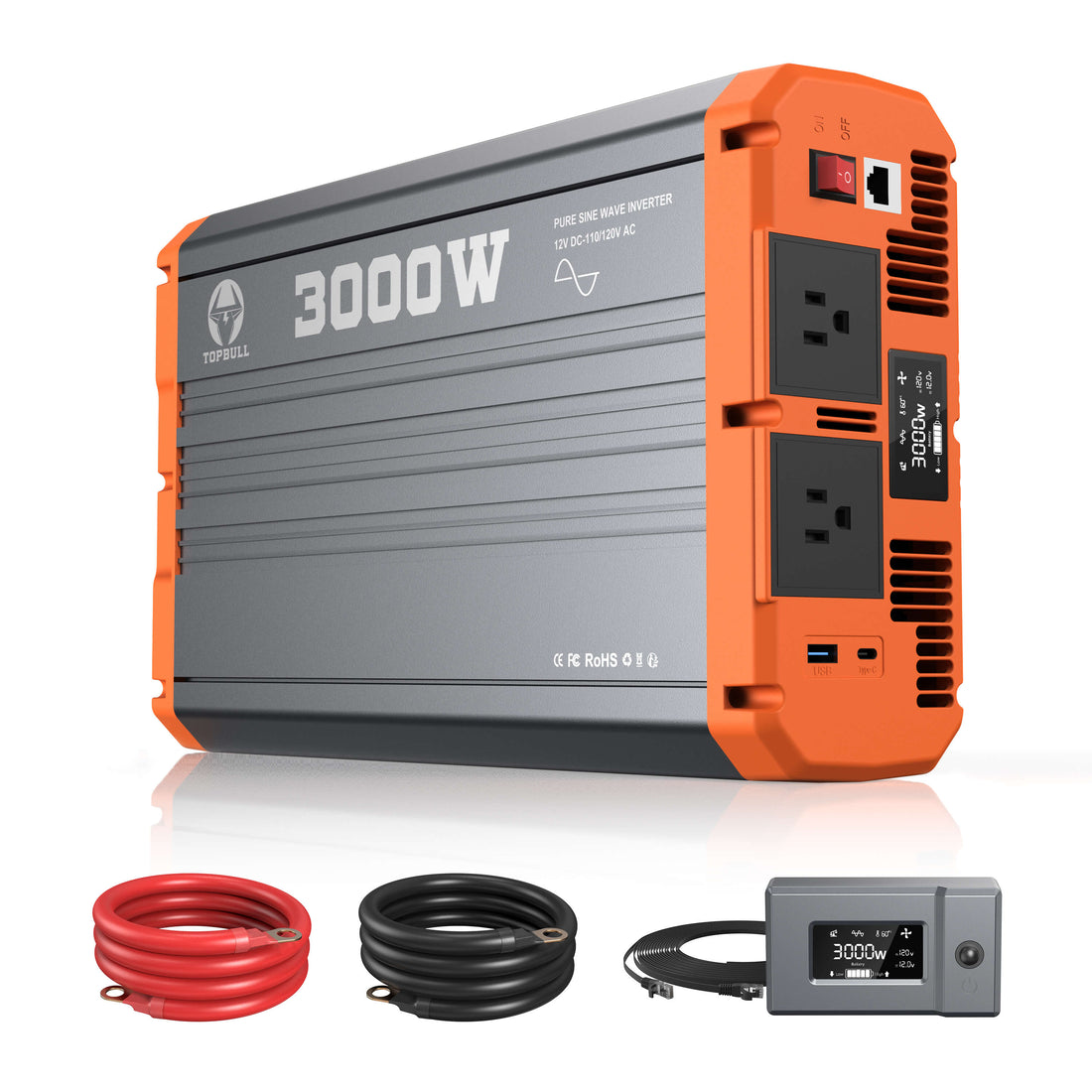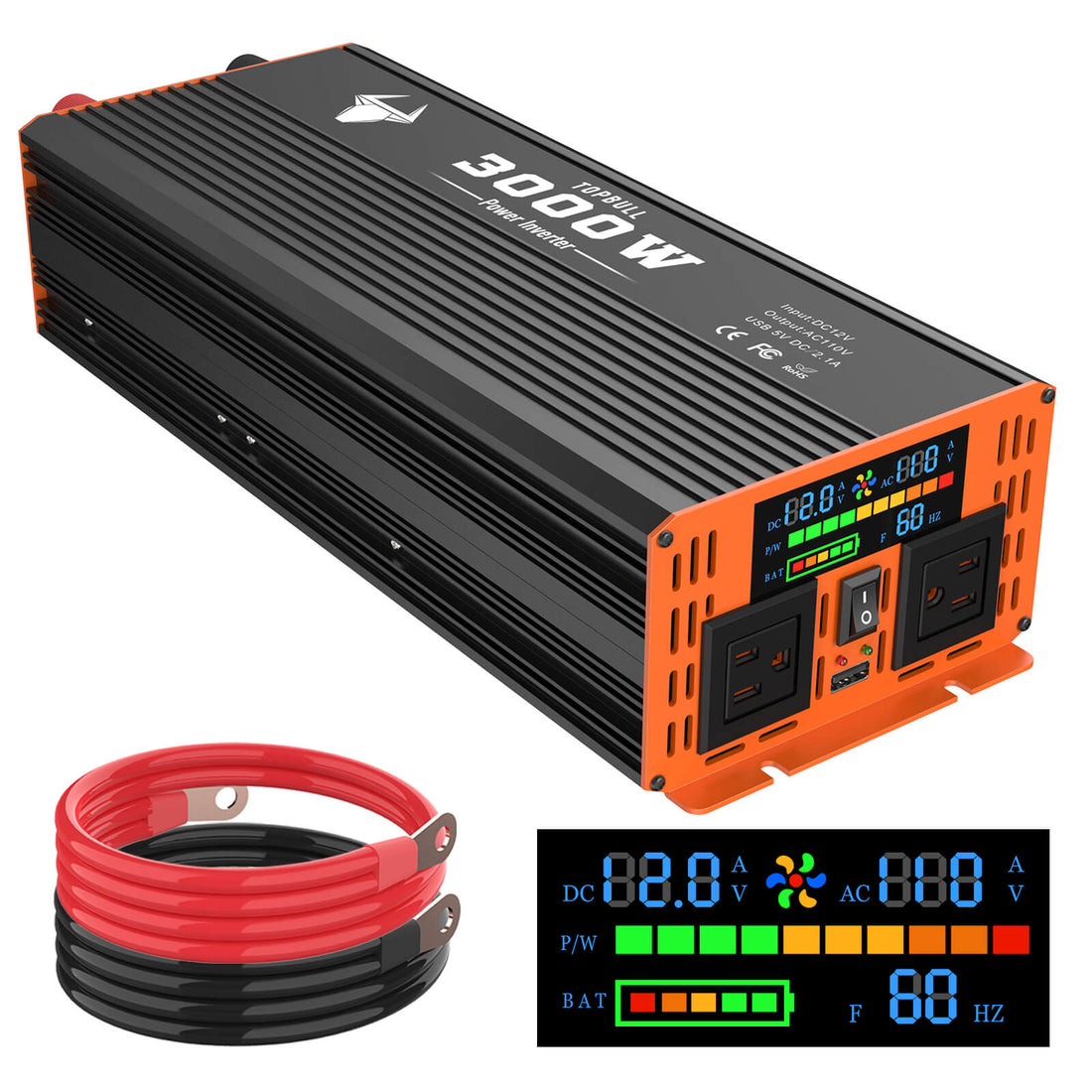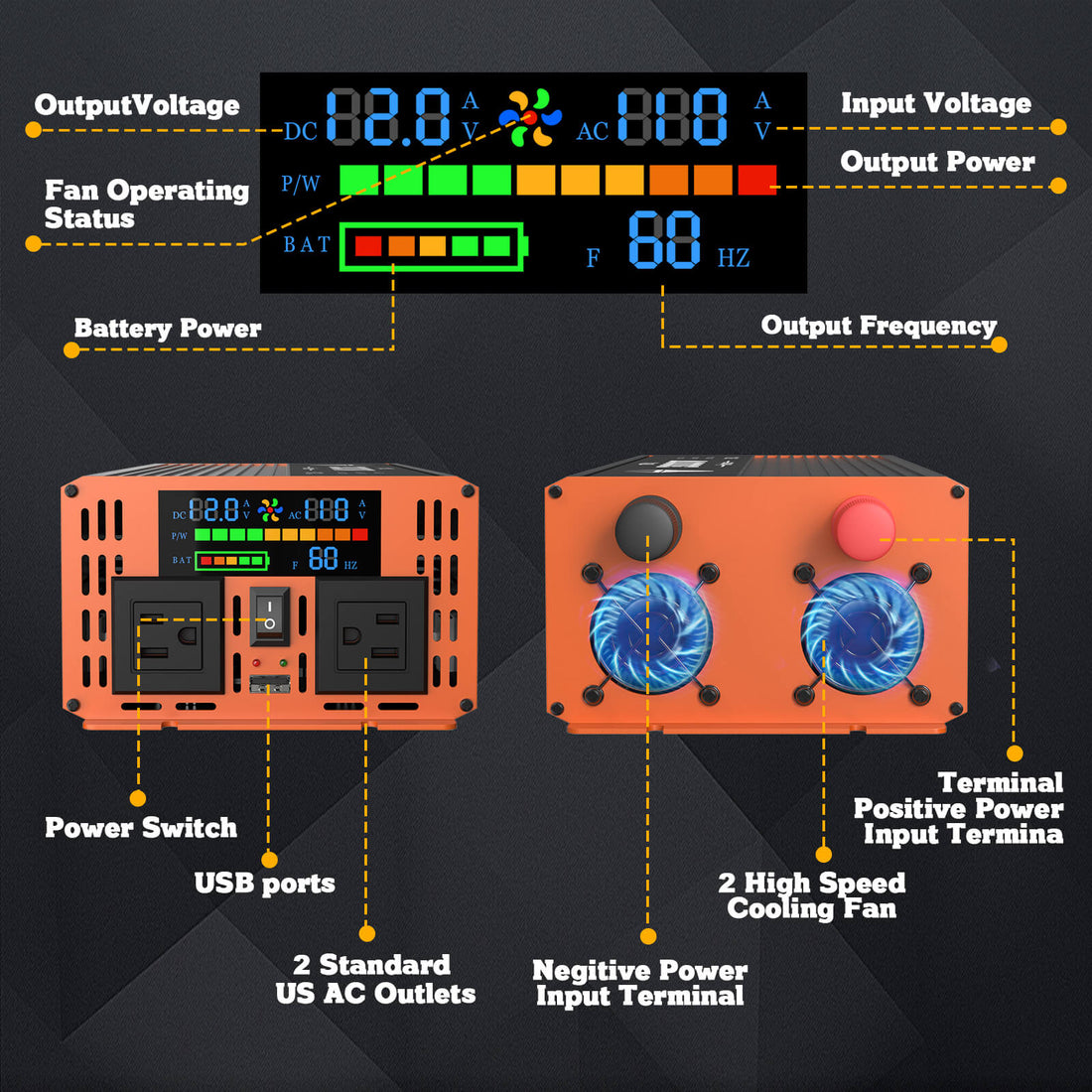Power Inverters
Inverter, the amazing power conversion tool! Our inverters can efficiently convert 12V DC to 110V/120V AC to meet the needs of various appliances and systems.Topbull provides two types of pure sine wave inverters and modified sine wave inverters, you can choose according to your actual needs.
TOPBULL sells 1000w, 1500w, 2000w, 2500w, 3000w, 3500w, 4000w and 5000w inverters. 100% real power continuous and stable output, 2x peak starting power, heavy duty continuous output, multiple safety protection, silent, good heat dissipation, very suitable for RV, camping, outdoor, 12V battery, truck, Yacht, off-grid solar and home emergency scenarios.
Choose our inverter products to experience the convenience and efficiency of power conversion and provide strong support for your power applications! New Arrivals $100 off for a limited time, plus 5% off your first order!
- Featured
- Best selling
- Alphabetically, A-Z
- Alphabetically, Z-A
- Price, low to high
- Price, high to low
- Date, old to new
- Date, new to old
Recently Viewed Products
FAQs About Power Inverters
What does an inverter do?
The main function of an inverter is to convert DC power (such as that provided by batteries, storage batteries, etc.) into AC power (generally 220V 50HZ sine or square wave). This enables people to utilize DC power to provide stable and reliable power security for electrical devices that require AC power in a mobile state or special environment. Inverters are widely used in mobile office, mobile communication, mobile leisure and entertainment, and also play an important role in wind and solar power generation systems.
What are the main types of inverters? What type is the best?
The main types of inverters include active inverters, passive inverters, off-grid inverters, grid-connected inverters, two-level inverters, three-level inverters, multilevel inverters, high-power inverters, medium-power inverters, and low-power inverters. In addition, depending on the output waveform, inverters can be categorized as pure sine wave inverters, modified sine wave inverters, and square wave inverters.
Which type is best depends on the specific application scenario and requirements. For example, in scenarios where high quality AC power is required, pure sine wave inverters are considered the best choice due to their stable sine wave output and wide load adaptability. In scenarios where waveforms are not required, modified sine wave inverters and square wave inverters are preferred due to their lower cost.
Difference between pure sine wave inverter and modified sine wave inverter
Waveform Output Characteristics: Pure sine wave inverters adopt PWM inverter technology (some of them also incorporate multi-step inverter technology), which has excellent output waveforms and can adapt to inductive and capacitive loads well. Modified sine wave inverters, on the other hand, mainly rely on square wave inverter (a few of them also incorporate ladder inverter technology), and their output waveforms are unsatisfactory and less suitable for inductive and capacitive loads.
Efficiency and Load Adaptability: Pure sine wave inverters show higher efficiency due to their stable sine wave output and the application of high-frequency technology, which can be adapted to a wider range of loads. Corrected sine wave inverters are mainly suitable for resistive loads, and if used for inductive appliances, they may generate more noise and cause more losses to the appliances.
How to choose the right inverter for you?
Power: Select the appropriate power level according to the type and number of appliances to be driven. The higher the power, the wider the range of application, but it will also consume more power and generate more heat.
Waveform: Choose the right type of inverter based on the waveform requirements of the appliances. Pure sine wave inverters are suitable for most appliances, especially those with precision or inductive loads; while modified sine wave inverters are suitable for scenarios that do not require high waveforms.
Protection Functions: Make sure the inverter is equipped with protection functions such as short-circuit, overload, over/under voltage, over-temperature, etc. to cope with abnormal situations and protect the safety of the equipment.
Brand and cost-effective: Choose well-known brands and cost-effective inverter products to ensure product quality and after-sales service.
What is the meaning of inverter's rated power?
The rated power of an inverter refers to the power it maintains for long-term operation, i.e. the maximum power that the inverter can continuously and stably output. This is an important parameter to consider when choosing an inverter.
What types of batteries can the inverter be used with?
The inverter can be used with many types of batteries, including but not limited to lithium batteries, lead-acid batteries, nickel-metal hydride batteries and so on. These batteries are used as a DC power source and are converted to AC power by the inverter for use in electrical equipment. When selecting a battery, factors such as its voltage, capacity and discharge characteristics need to be considered to ensure compatibility with the inverter.
Does an inverter add power?
The inverter itself does not add power. It is simply an energy conversion device that converts DC energy into AC energy. However, the output power of an inverter is usually slightly less than its input power due to certain losses during operation (e.g. conversion efficiency is not exactly 100%).
Does the inverter damage the battery?
The inverter will not damage the battery under normal use. However, if the inverter is faulty or used incorrectly (e.g. overload, short circuit, etc.), it may cause damage to the battery. Therefore, you need to pay attention to the following points when using the inverter:
- Make sure the input voltage of the inverter matches the rated voltage of the battery;
- Avoid operating the inverter in an overloaded or short-circuit condition for a long time;
- Regular inspection and maintenance of the inverter to ensure its proper operation.
Does the inverter produce noise?
The inverter may generate some noise during operation, which mainly depends on factors such as the design, manufacture and usage environment of the inverter. Generally speaking, the noise level of pure sine wave inverters is relatively low due to the advanced inverter technology and filtering circuits; whereas modified sine wave inverters and square wave inverters may generate greater noise due to the different inversion methods. In addition, the cooling fan of the inverter is also a source of noise generation. In order to minimize the impact of noise on the usage environment, you can choose inverter products with low noise design or take noise reduction measures (e.g. adding soundproof materials, etc.).
What is the service life of an inverter?
The service life of an inverter is affected by a variety of factors, including product quality, usage environment, load conditions, maintenance and so on. Generally speaking, high quality inverters can be used for many years or even more than ten years under normal use and maintenance.














